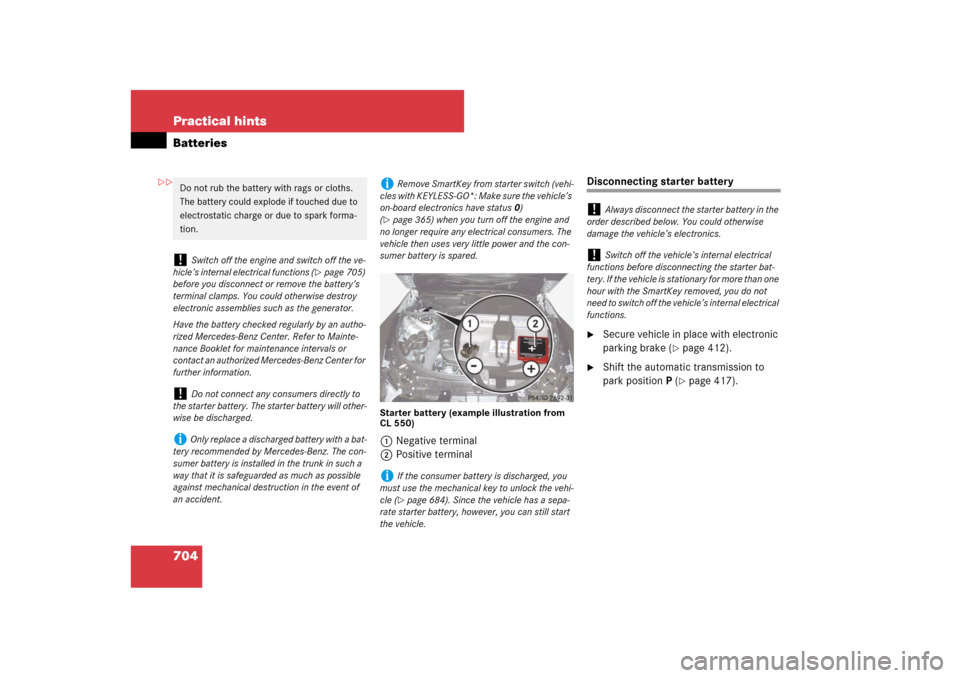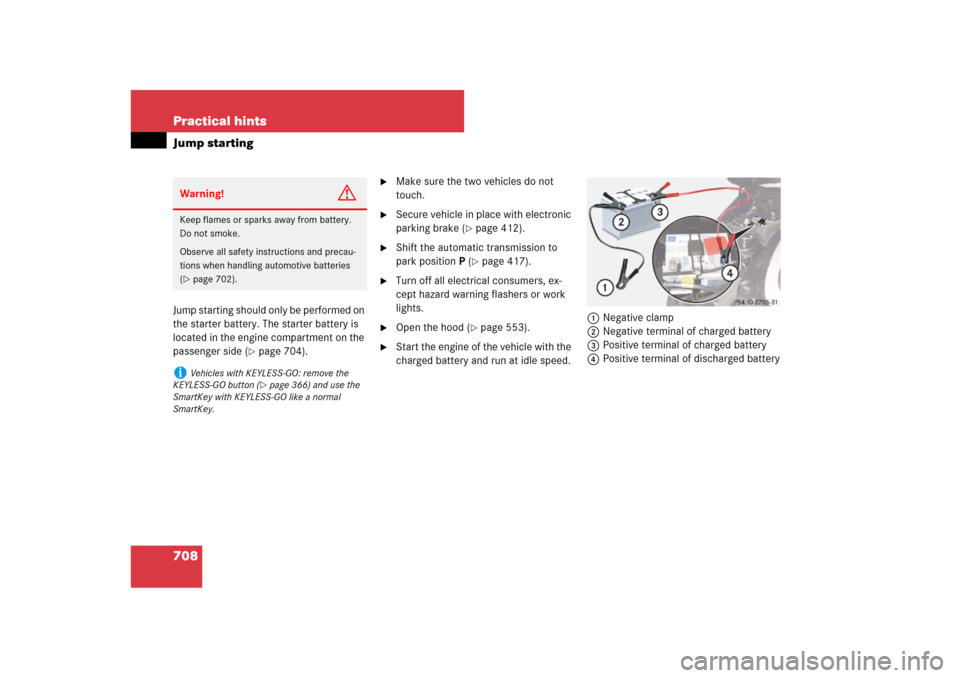Page 689 of 769
688 Practical hintsReplacing bulbsSafe vehicle operation depends on proper
exterior lighting and signaling. It is there-
fore essential that all bulbs and lamp as-
semblies are in good working order at all
times.
Correct headlamp adjustment is extremely
important. Have headlamps checked and
readjusted at regular intervals and when a
bulb has been replaced. See an authorized
Mercedes-Benz Center for headlamp ad-
justment.
i
If the headlamps or front fog lamps are
fogged up on the inside as a result of high humid-
ity, driving the vehicle a distance with the lights
on should clear up the fogging.
i
Substitute bulbs will be brought into use
when the following lamps malfunction:
�
Brake lamps
�
Rear fog lamps
�
Front parking lamps
�
Tail lamps
�
Turn signal lamps
Read and observe messages in the multifunction
display (
�page 622).
Page 690 of 769
689 Practical hints
Replacing bulbs
Bulbs Front lamps Rear lamps
Lamp
Type
1
Low and high beam
lamp
1
1Bi-Xenon headlamps: Low beam and high beam
use the same D1S-35W lamp. Do not replace the
Bi-Xenon bulbs yourself. Contact an authorized
Mercedes-Benz Center.
D1S-35 W
2
Additional turn signal
lamp
LED
3
Parking and standing
lamp
W5W
4
Side marker lamp
W5W
5
High beam flasher lamp
H7-55 W
IR emitter* (for Night
View Assist*)
H11-55 W
6
Corner-illuminating
lamp
H7-55 W
7
Fog lamp
H11-55 W
8
Turn signal lamp
PY 24 W
Lamp
Type
9
High mounted brake
lamp
LED
a
Turn signal lamp
HiP 16 W
b
Brake lamp/tail lamp
and standing lamp
LED
c
License plate lamp
W5W
d
Backup lamp
HiP 16 W
e
Side marker lamp
LED
f
Rear fog lamp (driver’s
side only)
HiP 19 W
Page 691 of 769

690 Practical hintsReplacing bulbsNotes on bulb replacement
�
Only use 12-volt-bulbs of the same
type and with the specified watt rating.
�
Switch lights off before changing a bulb
to prevent short circuits.
�
Always use a clean lint-free cloth when
handling bulbs.
�
Your hands should be dry and free of oil
and grease.
�
If the newly installed bulb does not
come on, contact an authorized
Mercedes-Benz Center.
Have the LEDs and bulbs for the following
lamps replaced by an authorized
Mercedes-Benz Center:
�
Bi-Xenon lamps
�
Front turn signal lamps
�
Front fog lamps
�
Additional turn signal lamps in the exte-
rior rear view mirrors
�
Parking and standing lamps
�
Front side marker lamps
�
High mounted brake lamp
�
Brake, tail and rear standing lamps
�
Rear side marker lamps
�
Rear fog lamp
�
Rear turn signal lamps
�
Rear side marker lamps
�
License plate lamps
Warning!
G
Bulbs and bulb sockets can be very hot. Al-
low the lamp to cool down before changing
a bulb.
Keep bulbs out of reach of children.
Halogen lamps contain pressurized gas. A
bulb can explode if you:�
touch or move it when hot
�
drop the bulb
�
scratch the bulb
Wear eye and hand protection.
Because of high voltage in Xenon lamps, it is
dangerous to replace the bulb or repair the
lamp and its components. We recommend
that you have such work done by a qualified
technician.
!
Do not replace the LEDs yourself. You could
otherwise damage the LEDs or parts of the vehi-
cle. Only have the LEDs replaced by an autho-
rized Mercedes-Benz Center.
i
Have the headlamp adjustment checked
regularly.
Page 697 of 769

696 Practical hintsFlat tirePreparing the vehicle�
Park the vehicle in a safe distance from
moving traffic on a hard, flat surface
when possible.
�
Turn on the hazard warning flasher
(�page 397).
�
Turn the steering wheel so that the
front wheels are in a straight ahead
position.
�
Shift the automatic transmission to
park positionP.
�
Engage the electronic parking brake.
�
Turn off the engine.
�
Have any passenger exit the vehicle at
a safe distance from the roadway.
�
Vehicles with SmartKey: Remove the
SmartKey from the starter switch.
Vehicles with KEYLESS-GO*: Open the
driver’s door (this puts the starter
switch in position0, same as with the
SmartKey removed from the starter
switch). The driver’s door then can be
closed again.�
Remove the KEYLESS-GO*
start/stop button from the starter
switch.
Mounting the spare wheel
i
Open the door only when conditions are safe
to do so.
Warning!
G
The dimensions of the spare wheel are dif-
ferent from those of the road wheels. As a
result, the vehicle handling characteristics
change when driving with a spare wheel
mounted. Adapt your driving style accord-
ingly.
The spare wheel is for temporary use only.
When driving with spare wheel mounted,
ensure proper tire inflation pressure and
do not exceed a vehicle speed
of 50 mph (80 km/h).
Contact the nearest Mercedes-Benz Center
as soon as possible to have the spare wheel
replaced with a regular road wheel.
Never operate the vehicle with more than
one spare wheel mounted.
Do not switch off the ESP
® when a spare
wheel is mounted.
Page 698 of 769

697 Practical hints
Flat tire
Preparing the vehicle�
Prepare the vehicle as described
(�page 696).
�
Take vehicle tool kit and vehicle jack
out of trunk (
�page 681).
�
Take the spare wheel and wheel bolts
out of the trunk (
�page 683).Lifting the vehicle
�
Prevent the vehicle from rolling away
by blocking wheels with wheel chocks
or other sizeable objects.
One wheel chock is included with the
vehicle tool kit (
�page 683).
When changing wheel on a level surface:
�
Place the wheel chock in front of and
another sizeable object behind the
wheel that is diagonally opposite to the
wheel being changed.
Always try lifting the vehicle using the jack
on a level surface. However, should cir-
cumstances require you to do so on a hill,
place the wheel chock and another size-
able object as follows:
�
Place the wheel chock and another
sizeable object on the downhill side
blocking both wheels on the side of the
vehicle not being worked on.
Warning!
G
The jack is designed exclusively for jacking
up the vehicle at the jack take-up brackets
built into both sides of the vehicle. To help
avoid personal injury, use the jack only to lift
the vehicle during a wheel change. Never
get beneath the vehicle while it is supported
by the jack. Keep hands and feet away from
the area under the lifted vehicle. Always en-
gage the electronic parking brake and block
wheels before raising vehicle with jack.
Do not disengage electronic parking brake
while the vehicle is raised. Be certain that
the jack is always vertical (plumb line) when
in use, especially on hills. Always try to use
the jack on level surface.
Make sure the jack arm is fully seated in the
jack take-up bracket. Always lower the vehi-
cle onto sufficient capacity jackstands be-
fore working under the vehicle.
��
Page 701 of 769
700 Practical hintsFlat tire1Wheel bolt for light alloy rims
2Wheel bolt for Minispare wheel
(located in trunk with spare wheel)
�
Clean contact surfaces of wheel and
wheel hub.
�
Guide the Minispare wheel onto the
alignment bolt and push it on.
�
Insert wheel bolts and tighten them
slightly.
�
Unscrew the alignment bolt, install the
last wheel bolt and tighten slightly.
Warning!
G
Only use genuine Mercedes-Benz wheel
bolts. Other wheel bolts may come loose.
Do not tighten the wheel bolts when the ve-
hicle is raised. Otherwise the vehicle could
fall off the jack.
!
Wheel bolts2 must be used when mount-
ing a Minispare wheel. The use of any wheel
bolts other than wheel bolts2 for a Minispare
wheel will physically damage the vehicle’s
brakes.
Warning!
G
Make sure to use the original length wheel
bolts when remounting the original wheel
after it has been repaired.
!
To avoid paint damage, place wheel flat
against hub and hold it there while installing first
wheel bolt.
Page 705 of 769

704 Practical hintsBatteries
Starter battery (example illustration from
CL 550)1Negative terminal
2Positive terminal
Disconnecting starter battery�
Secure vehicle in place with electronic
parking brake (
�page 412).
�
Shift the automatic transmission to
park positionP (
�page 417).
Do not rub the battery with rags or cloths.
The battery could explode if touched due to
electrostatic charge or due to spark forma-
tion.!
Switch off the engine and switch off the ve-
hicle’s internal electrical functions (
�page 705)
before you disconnect or remove the battery’s
terminal clamps. You could otherwise destroy
electronic assemblies such as the generator.
Have the battery checked regularly by an autho-
rized Mercedes-Benz Center. Refer to Mainte-
nance Booklet for maintenance intervals or
contact an authorized Mercedes-Benz Center for
further information.
!
Do not connect any consumers directly to
the starter battery. The starter battery will other-
wise be discharged.
i
Only replace a discharged battery with a bat-
tery recommended by Mercedes-Benz. The con-
sumer battery is installed in the trunk in such a
way that it is safeguarded as much as possible
against mechanical destruction in the event of
an accident.
i
Remove SmartKey from starter switch (vehi-
cles with KEYLESS-GO*: Make sure the vehicle’s
on-board electronics have status 0)
(
�page 365) when you turn off the engine and
no longer require any electrical consumers. The
vehicle then uses very little power and the con-
sumer battery is spared.
i
If the consumer battery is discharged, you
must use the mechanical key to unlock the vehi-
cle (�page 684). Since the vehicle has a sepa-
rate starter battery, however, you can still start
the vehicle.
!
Always disconnect the starter battery in the
order described below. You could otherwise
damage the vehicle’s electronics.
!
Switch off the vehicle’s internal electrical
functions before disconnecting the starter bat-
tery. If the vehicle is stationary for more than one
hour with the SmartKey removed, you do not
need to switch off the vehicle’s internal electrical
functions.
��
Page 709 of 769

708 Practical hintsJump startingJump starting should only be performed on
the starter battery. The starter battery is
located in the engine compartment on the
passenger side (
�page 704).
�
Make sure the two vehicles do not
touch.
�
Secure vehicle in place with electronic
parking brake (
�page 412).
�
Shift the automatic transmission to
park positionP (
�page 417).
�
Turn off all electrical consumers, ex-
cept hazard warning flashers or work
lights.
�
Open the hood (
�page 553).
�
Start the engine of the vehicle with the
charged battery and run at idle speed.1Negative clamp
2Negative terminal of charged battery
3Positive terminal of charged battery
4Positive terminal of discharged battery
Warning!
G
Keep flames or sparks away from battery.
Do not smoke.
Observe all safety instructions and precau-
tions when handling automotive batteries
(�page 702).
i
Vehicles with KEYLESS-GO: remove the
KEYLESS-GO button (
�page 366) and use the
SmartKey with KEYLESS-GO like a normal
SmartKey.